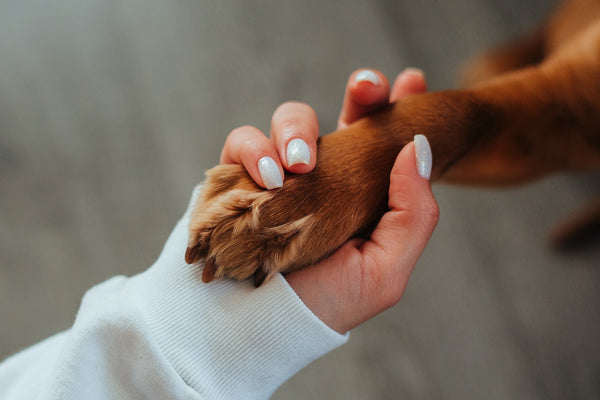Puppies provide some of the greatest joys life has to offer. They’re playful, goofy, and filled with life. Sadly, their beautiful energy is bound to have a downside!
That downside is often not knowing the limits of their strength. Puppies are still developing mentally and socially, learning from you the ways of the world. These fuzzy cannonballs are often so loyal and devoted to their owners they’ll even try to hide their injuries. Some dog breeds are more likely to incur leg injuries than others, too.
When your puppy is limping, there’s always a reason. We will tackle the common causes of why your puppy limps and what you can do to keep them safe.
We all need help keeping an eye on our puppy. We designed our business to give dog owners the clothes, accessories, and knowledge needed to raise a healthy dog.
What to Look For in a Damaged Puppy Limb
Did you know a pet in the United States needs an emergency vet visit every 2.5 seconds? While animals are generally cautious, they can still make mistakes or have a foolish moment.
Nowhere is this fact more evident than in the puppy. Puppies are filled with seemingly endless energy. Through play and roughhousing, they learn the limits of their strength or how to socialize. When they go too far, they get a limp.
A painful puppy limb might have the following:
- Wrist at a strange angle
- A broken bone
- Something stuck in the paw pad or between the toes
- Inflamed muscle
- Swollen or reddened skin
A Gradual or Sudden Limp?

Determining how quickly the limp happened will tell you a lot. A sudden limp is likely caused by stepping on something sharp or twisting a limb during playtime. A gradual limp is often a sign of a degenerative condition, such as joint inflammation or degradation.
The most common degenerative conditions in dogs are osteoarthritis and hip dysplasia. The former state creates joint inflammation from lost cartilage, which is usually (but not always) affected by age. Cartilage is the body’s cushion, reducing stress caused by movement. Without sufficient cartilage, the movement of bones and muscles causes excess pain.
Hip dysplasia is another issue that commonly affects purebred dogs (particularly German Shepards, Pugs, and Labradors). This hereditary condition causes extreme stiffness, pain, and sometimes limping.
It’s usually a good idea to make an appointment with your regular vet to determine the exact reason why your dog is limping and to receive directions for possible treatments. However, there are often some additional steps that you can take to help make things easier for your struggling pup once you know what’s going on. For example, dogs with hip dysplasia- especially larger, older dogs- can often find some relief from wearing quality-made dog shoes.
A decent set of dog shoes can provide some extra support and padding that helps minimize some of the pressure that dogs experience in their bones and joints. While this won’t get rid of their issue, it can help improve their quality of life.
Related: How to Calm a Dog When They're Anxious
Strained or Torn Muscles
As touched on above, sudden limps are usually the result of immediate concerns. Your puppy might have stepped on a thorn or pulled a muscle while roughhousing.
Have you ever torn a muscle before? If you have, you already have a powerful idea of what your puppy is experiencing. Torn muscles are quite painful and take at least a week to heal fully. Your puppy will need to spend time inside as they heal and may need a trip to the vet for a cast.
Related: Dog Refuses To Walk? Here Is What You're Doing Wrong
Broken Bones

You’ll know if your puppy has a broken bone by the severity of their limp. A broken bone often bends the limb in a visible way and may even poke through the skin.
Never try to reposition the limb on your own. Veterinarians are extremely experienced in their field and will be able to set the bone back during your visit. They’ll give your dog a cast, medication, and rest time for them to recover fully.
Superficial Injury
Sometimes your puppy’s limp is a minor issue. Like us, they can limp after stubbing their toe or bumping into furniture.
Always double-check your puppy for damage, but if you don’t find anything, rest easy. Keep an eye on your furry baby for the next few hours to ensure nothing else changes.
Insect or Tick Bite
Puppies are very susceptible to insect or tick bites. If you haven’t already, make sure your puppy has been vaccinated for common dog-related diseases.
If you suspect your puppy got bit, sit them down and root through the fur. If you find a tick, we recommend removing it as soon as possible. Ticks carry several diseases, one of which is the debilitating Lyme’s Disease. If you don’t know how to properly remove a tick, consult a vet immediately.
If you suspect a spider bite, always assume the spider is poisonous and contact your health professional.
How to Diagnose and Treat Minor Paw Sprains
Sprained paws are one of the downfalls of puppyhood. Their addiction to playtime has the side-effect of routinely straining their delicate paws.
If your puppy has a sprain, it’s important to give them rest. Resist taking them out to the park and contact your vet for advice. They might recommend wrapping the paw in gauze, applying ice, or taking them in for a visit. They may also recommend purchasing some quality dog shoes that can offer your pup an extra layer of comfort and protection.
Related: Why Do Dogs Bring You Toys When You Get Home?
Final Word

The reason we stress taking your puppy to the vet so often is because they’re the most reliable experts. They’ll quickly diagnose any health problem you give them and provide the best solution.
Next time you ask, “Why is my puppy limping?”, remember these tips. While you can’t prevent them from getting a sprain or a bug bite, you can act swiftly.
Give your dog the most comfortable and snug clothes around. Contact us today for state of the art dog boots, dog hoodies, and accessories.










